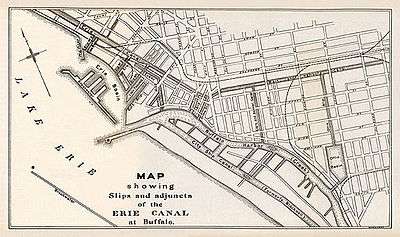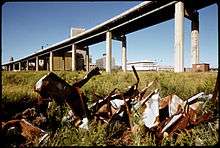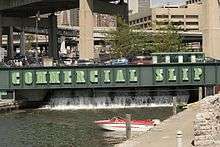Canalside District, Buffalo

Canalside is a historic redevelopment district within Buffalo, New York that was once the western terminus of the Erie Canal. Today, it has become a rich site of development, revival, and activity in Buffalo. The site includes the Commercial Slip, historically reconstructed Erie Canal and Main-Hamburg Canals and a mix of building including: KeyBank Center, the Buffalo and Erie County Naval & Military Park and HarborCenter among others.[1]
Early history

Originally built in Buffalo, New York in 1825 as the "portal to the west", the Erie Canal Harbor served as the terminus for the passage of goods and passengers from the East Coast across the Great Lakes for much of the 19th century. More importantly for Buffalo, the commercial activity fueled by the harbor helped transform the city into a thriving metropolis. Buffalo's notorious Canal Street was a short distance from the canal terminus.
The area had been the site of the original Village of Buffalo, near a Seneca Indian village on Buffalo Creek. The city eventually expanded outward from the waterfront location.
The Canal, completed in 1825, opened up the western United States to travelers and trade from the east coast. With it came a tremendous increase in Great Lakes freighter traffic at Buffalo harbor, and with that an influx of canal and freighter crewmen who were often paid off in Buffalo and spent freely in the bars and brothels that sprang up in the district, known variously as "Canal Street", "Five Points" "the Flats" and "the Hooks".
In the early 20th century, the district became the home of Italian immigrants, mostly Sicilian. Canal Street's name was changed to Dante Place and the neighborhood became known as Dante Place or "Little Italy." Most of the bars and brothels gave way to three- and four-story brick tenements, each housing multiple families.

By the late 1920s, the Canal had been filled in, and in the 1950s, urban renewal obliterated the historic site.
The Commercial Slip was a remnant of Little Buffalo Creek, which flowed into the Buffalo River just before the larger stream entered Lake Erie. The Commercial Slip formed one boundary of Buffalo's infamous Canal District, and was filled in when the district was marked for urban renewal in the 1950s. By that time, the New York State Thruway and the Skyway and Buffalo Memorial Auditorium had been built over the Canal district, and the Commercial Slip was buried and forgotten.
1936 explosion
Throughout its existence, the neighborhood suffered numerous fires, explosions, and other disasters. The most notable occurred on January 1, 1936 very early in the morning. Joseph Lopresti at 40 LeCouteulx just across the street from Our Lady of Mount Carmel Church came home from Mass, lit a candle, and went into his tenement basement to get some wine. He was outside accessing the basement doors when the building exploded.
The cellar had apparently been filled with natural gas that had leaked into it the night before. The force of the explosion, for a split second, lifted the entire tenement off its foundation and then it collapsed with a horrible, sickening sound and a shower of bricks, broken glass, and splinters of wood. The windows in the church across the street all blew out. Five people died in the blast – Lopresti and his wife, and Gaetano (Thomas) and Mary Scorsone along with their eldest child Anna, aged 12.
Rescue workers had to pull people from the rubble. There were several survivors. Eyewitnesses say that there was a man with a motion picture camera filming the incident, which leads to a theory of a possible mob hit. This brought national attention to slum areas and new legislation was passed. The sad part, according to survivor Antoinette Scorsone Militello, was that her father had put a downpayment on a house and were to be moving out shortly. Mary(who was with child) & Thomas were survived by three of their children – Antoinette, Peter & baby Rosalie.
Reconstruction and redevelopment
Demolition of Buffalo Memorial Auditorium and Slip, 2006-08

In the late 1990s, public authorities began showing an interest in reviving Buffalo's Erie Canal heritage. Initially, plans called for re-creating some buried elements of the Canal. However a public outcry, with pressure from citizens’ groups and the local media, convinced the planners to excavate and restore actual portions of the district, including the Commercial Slip.
The Erie Canal Redevelopment project unearthed building foundations from the Canal-era neighborhood and restored the Commercial Slip, which formed the original natural outlet of Little Buffalo Creek into the Buffalo River.
Completed in 2008, Phase 2 of inner harbor plan laid out by the Erie Canal Harbor Development Corporation consisted of:[2]
- A re-watered navigable Commercial Slip in alignment with the original Commercial Slip.
- A towpath/walkway on the west and east sides of the Commercial Slip.
- Construction of a bowstring truss bridge.
- Commercial Street reconstructed and made available for service and emergency access.
- Steamboat Hotel and Lloyd Street ruins uncovered and preserved as an archeological site with a combination hard and grass surface.
- Site of the former Union Block as an interpreted site with a grassy, sloped lawn.

From 2008 to 2009 the former Buffalo Memorial Auditorium was demolished, as it was an ailing structure. Initially, plans were in place to construct a Bass Pro store on the location. The plans eventually were scrapped as Bass Pro decided against the location.[3]
As the culmination of nearly a decade's worth of effort, the first phase of the historic canal harbor area redevelopment opened to the public in 2008. It included the recreation of several distinctive features of the original Canal district, such as the Commercial Slip, which served as the historic juncture between the Erie Canal and the Great Lakes; the wooden-plank Central Wharf, which stretched from the foot of Main Street to the Commercial Slip; the award-winning Whipple Truss foot bridge, which accurately resembles traditional canal spans and connects the Central Wharf to the cobblestone Commercial Street; prominent canal-era buildings, which house various naval and military artifacts; as well as the excavation site of the original Steamship Hotel building foundations, which are presented alongside several interpretive exhibits showcasing the historical significance of the Erie Canal.
Replicating canals: 2009–2014
Canals with a freezing system were built to replicate historic canals. The canals were constructed on the old Memorial Auditorium site and were completed in 2014.[4] The canals have water in the spring and summer and ice in the winter for skating and ice biking.
Economic development
The first major private development in Canal Side was the Buffalo Sabres' hockey themed HarborCenter. The development is the most expensive privately funded single building in City of Buffalo history. Construction of the project began in March 2013.[5] The building contains two NHL sized hockey rinks, a parking garage, restaurants, a hotel and retail space. The building was fully completed in 2015.[6]
Location

The Canalside is located at the intersection of Scott and Lloyd streets in downtown Buffalo, New York and can be accessed through a temporary entrance near the Commercial Slip, or by way of the Buffalo and Erie County Naval & Military Park located on the western edge of the harbor. The City of Buffalo operates floating docks on the harbor site, including hourly water and electric service for up to 40 vessels which began the summer of 2010.
There is a dock for boats, Water Bike rentals, kayak rentals, a sailing school, sunset and daytime sailboat rides. The Miss Buffalo is sometimes docked there. The Naval Park is directly next to Canalside. First Niagara Center is also within a few feet. The NFTA metro rail is free downtown and runs along Main Street with a stop at Erie Canal Harbor station.
Buffalo Place hosts Thursday and Friday Concerts, Thursdays are generally free while Fridays are relatively low cost show, $10 – $20. Major acts include Wallflowers, Salt n' Pepa, LL Cool J, Yonder Mountain String Band, Lotus, moe., G. Love, Halestrom, O.A.R.. Previously listed at Thursday at the Square, moved to Canalside after it was updated. On June 24, 2016 Canalside hosted the FanFest for the 2016 NHL Draft which was hosted next door in First Niagara Center.
See also
References
Modern
- ↑ "City picks Pegula's Webster Block plan". WIVB.com. WIVB.com. Retrieved 22 January 2013.
- ↑ "ECHDC Website". Erie Canal Harbor Development Corporation. Retrieved May 17, 2012.
- ↑ "Bass Pro Out of Buffalo". WGRZ.com. WGRZ TV. Retrieved 22 January 2013.
- ↑ "Canal To Be Built at Old Aud Site". WGRZ.com. WGRZ.com. Retrieved 22 January 2013.
- ↑ Terreri, Jill (11 March 2013). "Streets to close around First Niagara Center". Buffalo News. Retrieved 10 April 2013.
- ↑ Terreri, Jill (13 February 2013). "Cost of Sabres' HARBORcenter project rises 40% to $170 million". Buffalo News. Retrieved 10 April 2013.
Historical
- Vogel, M.N., Patton, E.J., Redding, P.F. America's Crossroads: Buffalo's Canal Street/Dante Place. Buffalo, New York: Western New York Heritage Press, ©1993 (ISBN 1-878097-12-1)
- http://www.eriecanalharbor.com/pdf/72BuffaloGuide.pdf THOMAS X. GRASSO
President, Canal Society of New York State
- Antoinette Scorsone Militello, survivor, in stories related to her Grandchildren.
External links
- Canalside is covered in the
 Downtown Buffalo travel guide from Wikivoyage.
Downtown Buffalo travel guide from Wikivoyage.
| Wikimedia Commons has media related to Canalside, Buffalo, New York. |
Modern
Historical
- Maps of Buffalo's Erie Canal District then and now
- The Relationship of the Canal to Buffalo and its Harbor, 1845-2000: a collection of maps and images
Coordinates: 42°52′35″N 78°52′45″W / 42.87639°N 78.87917°W